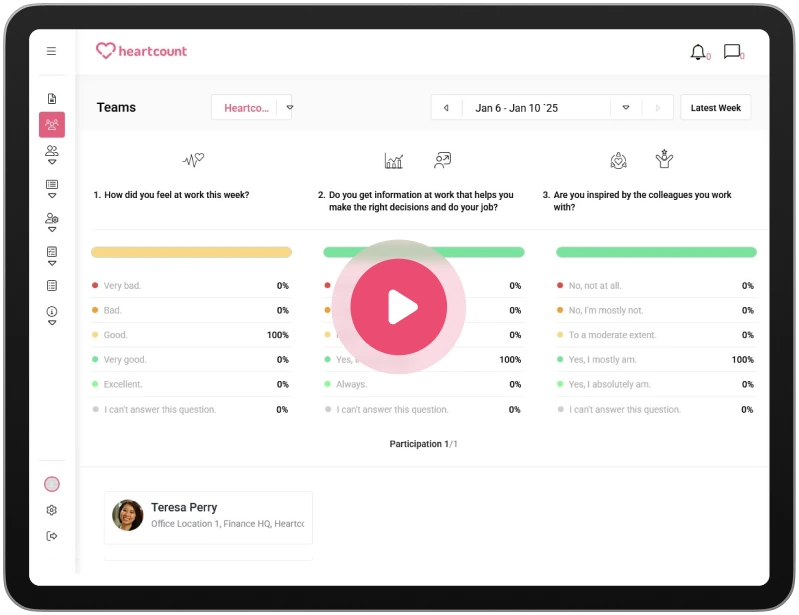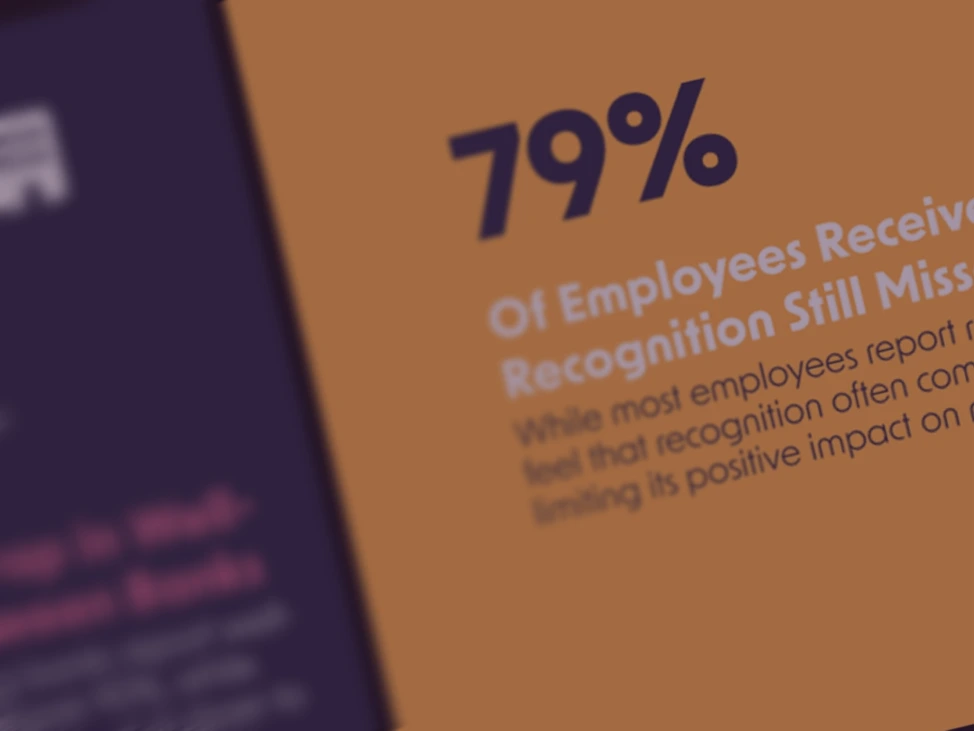Employee Attrition: Definition, Rate Formula & Data-Driven Ways to Reduce It

The World Economic Forum’s 2023 report found that one in five workers around the world plans to leave their job within the next year. In fields with a lot of turnover, like tech, healthcare, and retail, attrition isn’t just a number on a dashboard; it’s a serious business risk.
Understanding why employees leave is no longer an option. Companies need a plan to keep an eye on, predict, and cut down on talent loss, whether it’s through silent resignations, early retirements, or burnout.
In this guide, we’ll explain what employee attrition really means, how to figure it out, what healthy and unhealthy attrition looks like, and most importantly, what you can do to stop it before your best workers leave
We’ll also explore how platforms like HeartCount help teams use real-time feedback, sentiment tracking, and automated insights to reduce attrition and strengthen employee experience from the ground up.
-
1.What Is Employee Attrition?
-
2.Why Attrition Matters to Your Business
-
3.How to Calculate Your Employee Attrition Rate
-
4.Types of Employee Attrition
-
5.Top 10 Causes of High Attrition — and How to Fix Them
-
6.Predicting Attrition Before It Happens
-
7.Action Plan: Reduce Harmful Attrition & Keep Top Talent
-
8.FAQ: Employee Attrition Explained
The World Economic Forum’s 2023 report found that one in five workers around the world plans to leave their job within the next year. In fields with a lot of turnover, like tech, healthcare, and retail, attrition isn’t just a number on a dashboard; it’s a serious business risk.
Understanding why employees leave is no longer an option. Companies need a plan to keep an eye on, predict, and cut down on talent loss, whether it’s through silent resignations, early retirements, or burnout.
In this guide, we’ll explain what employee attrition really means, how to figure it out, what healthy and unhealthy attrition looks like, and most importantly, what you can do to stop it before your best workers leave
We’ll also explore how platforms like HeartCount help teams use real-time feedback, sentiment tracking, and automated insights to reduce attrition and strengthen employee experience from the ground up.
What Is Employee Attrition?
Employee attrition is the gradual reduction of your workforce when employees leave and their roles remain unfilled. It’s not the same as turnover, where someone exits and is quickly replaced. When someone quits, the job goes away, either for a short time or forever.
Companies can find patterns in employee exits, understand changes in the workforce, and flag possible problems with leadership, culture, or career development by keeping track of attrition.
Employee Attrition Meaning vs. Turnover
Although often confused, attrition and turnover describe different outcomes. Attrition happens when someone leaves and the company chooses not to refill the role — like after a retirement or long-tenured exit. Turnover involves rehiring for the same position.
In short: turnover is replacement-focused; attrition reflects a net loss in headcount.
Attrition vs. Retention: Key Differences
Attrition tells you how many people are quitting. Retention tells you how many people are staying. They are both parts of the same equation. If you have low attrition, it usually means that your strategies for keeping and engaging employees are working, whether that’s through meaningful work, career growth, or moving up within the company.
Check out our guide to employee engagement and retention for more information on how these strategies work together.
Healthy vs. Unhealthy Attrition
Not all attrition is a red flag. Sometimes it’s necessary — like when underperformance is an issue or teams need to evolve. But when your best people are walking out the door, that’s unhealthy attrition.
According to McKinsey research, a lack of flexibility, purpose, or opportunity for advancement is the main reason why many employees quit their jobs rather than pay. Understanding the distinction between beneficial and detrimental attrition enables you to respond with appropriate solutions, not just additional hiring.
Why Attrition Matters to Your Business
Employee attrition has a direct impact on your company’s productivity, culture, and bottom line in addition to headcount. Although some attrition is to be expected, if it is not controlled, it can pose a significant risk to the organization.
The Real Cost of Lost Talent
It costs more than just the employee’s salary each time they leave. Gallup estimates that voluntary turnover costs American companies more than $1 trillion a year. When recruiting, onboarding, training, and productivity gaps are taken into account, replacing an employee can cost up to twice their yearly salary.
Attrition also drains institutional knowledge — especially when experienced employees exit without proper knowledge transfer.
Cultural and Productivity Impact
Attrition has an impact on team morale, consistency, and collaboration in addition to finances. Regular departures undermine trust and cause instability. Engaged team members may become disengaged or, worse, decide to quit if they observe high turnover around them.
Cultural attrition is frequently caused by burnout, a lack of feedback, and poor leadership. Frequent surveys of employee satisfaction also provide important information about declines in engagement before they become departures.
2025 Industry Benchmarks: Attrition by Sector
Companies that invest in culture, recognition, and flexibility tend to retain talent for longer, though attrition rates vary by industry.
- Because of their fast-paced work environments and competitive hiring practices, tech and startups frequently see rates between 15 and 20 percent per year.
- Due to staffing shortages and burnout, the healthcare industry has one of the highest attrition rates, occasionally surpassing 25%.
- Manufacturing and retail are high turnover industries where frontline employee attrition can reach 30%.
For background, LinkedIn’s Workforce Insights indicates that perceived disconnection from leadership, discontent with hybrid policies, and a lack of career advancement are the main causes of attrition.
How to Calculate Your Employee Attrition Rate
You can determine whether your workforce is declining at a sustainable rate and how quickly it is happening over time by knowing your employee attrition rate. It’s one of the easiest HR metrics to monitor, but it’s also one of the most ignored.
Step-by-Step Formula
The standard formula for calculating attrition is:
Attrition Rate (%) = (Number of Employees Who Left ÷ Average Number of Employees) × 100
Where:
- Employees who left = during a specific time period (typically quarterly or annually)
- Average number of employees = (Starting headcount + Ending headcount) ÷ 2
Worked Example With Numbers
Let’s say your company started the year with 120 employees and ended with 100. During that year, 30 people left and weren’t replaced.
- Average headcount = (120 + 100) ÷ 2 = 110
- Attrition Rate = (30 ÷ 110) × 100 = 27.3%
This indicates a relatively high attrition rate, especially if your industry benchmark is closer to 15%.
What Is a Good Attrition Rate?
There’s no universal benchmark, but most stable organisations aim for a rate between 10–15% annually. Anything significantly above that should prompt further investigation — especially if high-performers are leaving.
That’s where tools like HeartCount’s employee experience platform can help. With real-time data on sentiment and exit signals, you can go beyond spreadsheets and spot trends before they escalate.
Types of Employee Attrition
Not all attrition is created equal. To understand what’s happening within your workforce, it’s important to break attrition down into categories. Each type reveals different causes, and requires different responses.
Voluntary Attrition
This happens when workers decide to quit on their own, usually for personal reasons, better benefits, a new job, or more flexibility. It is the most prevalent type of attrition and frequently the most avoidable.
When top performers leave, it’s typically an indication of more serious problems like poor leadership, misaligned values, or a lack of progress. These risks can be identified before they become exits through early feedback and routine pulse surveys.
Involuntary Attrition
Layoffs, terminations, and restructuring are all included in this. Employer-initiated, it may be motivated by organizational change, budget cuts, or performance concerns.
High rates of involuntary attrition can breed mistrust and anxiety among teams, even though they are occasionally required. Transparency and fair performance management processes are essential here.
Retirement & Demographic Shifts
Retirement-related attrition is expected, but can still impact teams — especially when experienced employees take knowledge with them. The key to controlling this type of attrition is succession planning and organized knowledge transfer.
Different retention tactics, like phased retirement or part-time transitions, may be needed for an aging workforce than for younger workers.
Natural/Internal Movement Attrition
Employees moving to different positions within the company can occasionally result in attrition. Although it technically lowers headcount in one area, it frequently indicates healthy mobility.
That said, too much internal movement without planning can create talent gaps. Tracking these patterns through a platform like HeartCount can help you balance mobility with team stability.
Top 10 Causes of High Attrition — and How to Fix Them
Improving retention begins with understanding the reasons behind employee departures. Ten of the most frequent causes of high employee attrition are listed below, along with tried-and-true solutions.
1. Lack of Growth & Development
Workers will leave your organization if they don’t see a future there. One of the main reasons people leave is growth stagnation, which can be caused by a lack of stretch opportunities, unclear career paths, or inadequate training.
Make it right: Introduce cross-functional learning, mentorship programs, and development plans. Ask staff members how supported they feel in their personal development by using pulse surveys.
2. Compensation & Benefits Gaps
Even though it’s not always the primary cause of departure, unjust or uncompetitive pay can quickly turn into a deal-breaker, particularly when combined with better offers from other places.
Make it right: Make sure pay structures are transparent and benchmark the market on a regular basis. Review perks like equity options, wellness assistance, and flexible scheduling.
3. Poor Leadership & Management
Not only do people quit their jobs, they also quit their managers. Trust and motivation can be swiftly undermined by micromanagement, unclear expectations, or a lack of feedback.
Make it right: Teach managers how to create psychological safety and give constructive criticism. Our employee feedback guide outlines best practices that managers can implement immediately.
4. Burnout & Work-Life Imbalance
High emotional load, ambiguous boundaries, and persistent overwork are the main contributors to burnout-related attrition. Workers may quietly disengage and depart without expressing that they are burned out.
Make it right: Track workload patterns, model balance from the top down, and take early action based on real-time data. Our guide to burnout provides practical strategies for lowering stress before it results in burnout.
5. Culture Misalignment & DEI Gaps
Employees are more likely to disengage and quit when they don’t feel like they belong. Attrition can be subtly caused by a lack of inclusive practices, a poor alignment of values, or a tolerance for toxic behavior.
Make it right: Integrate diversity, equity, and inclusion (DEI) into leadership development, hiring, and daily operations. Ensure that there are feedback systems in place to identify cultural issues early.
6. Limited Flexibility / Remote Misfit
The days of rigid work models are over. Workers desire flexibility in terms of not only where they work but also in terms of their hours, level of autonomy, and method of completion. Businesses that disregard this change run the risk of experiencing increased attrition.
Make it right: After understanding preferences with feedback tools, create flexible or hybrid models according to team requirements. A one-size-fits-all strategy won’t work.
7. Recognition & Appreciation Deficit
Particularly for high performers, motivation suffers when effort is not acknowledged. Lack of recognition eventually causes workers to look for settings where they are valued.
Make it right: Incorporate acknowledgment into team procedures and monitor and reward good behavior with HeartCount’s employee recognition feature.
8. Low Engagement & Purpose
Even if everything else appears to be going well on paper, employees who feel uninspired by their role or disengaged from the company’s mission are more likely to quit.
Make it right: Measure engagement on a regular basis to start, then take action based on your findings. Our guide to driving employee engagement includes proven strategies to reconnect people to purpose.
9. Job Insecurity & Company Instability
Even in the absence of layoffs, employees may depart early if they feel uneasy about the company’s leadership, finances, or direction.
Make it right: Communicate transparently and consistently. To address concerns before they become entrenched, use data to detect sentiment shifts early.
10. Hiring for Wrong Fit
Attrition can occasionally be the consequence of an initial mismatch. Early departures and weakened team cohesion may result from hiring practices that put speed ahead of alignment.
Make it right: To improve your hiring process over time, review job descriptions, interview several team members, and use information from onboarding surveys.
Predicting Attrition Before It Happens
Most employees don’t leave without warning — the signals are there. The key is having the right tools to detect them early. With real-time data and sentiment analysis, companies can shift from reacting to resignations to proactively addressing the causes.
Early Warning Signals from Weekly Pulse Surveys
Weekly pulse surveys offer a snapshot of how employees are feeling in the moment — far more effectively than annual engagement surveys. Consistent dips in sentiment, declining manager scores, or repeated concerns in open feedback are early signs of disengagement.
According to research by MIT Sloan, organisations that regularly gather and act on employee feedback experience 14% lower turnover rates than those that don’t.
Sentiment Trends & Risk Scoring
Modern platforms can track emotional tone and behavioural signals to identify employees who may be at risk of leaving. This includes analysing shifts in engagement, feedback patterns, burnout indicators, and even participation drop-offs.
A Visier study reported that customers using people analytics saw a 17% reduction in manager turnover within two years—and overall resignations dropped by about 3.5% thanks to data‑driven, team-level retention strategies
Listen → Diagnose → Act Framework
To effectively reduce unwanted attrition, companies need a closed feedback loop:
- Listen continuously through real-time surveys and check-ins
- Diagnose emerging issues using engagement data and trend analysis
- Act by coaching managers, addressing concerns, and adjusting policies quickly
This proactive cycle helps prevent small issues from becoming resignation letters — and builds trust by showing employees their feedback actually leads to change.
Action Plan: Reduce Harmful Attrition & Keep Top Talent
Once you understand why employees are leaving, the next step is turning insights into action. Below are four strategic focus areas that help reduce harmful attrition while building a workplace where people want to stay.
Build Growth and Recognition Pathways
Lack of development is one of the most cited reasons for employee exits. If people can’t envision a future at your company, they’ll find one elsewhere. Clear progression paths, access to learning opportunities, and consistent recognition help retain top talent — and motivate everyone else to grow.
According to LinkedIn’s Workplace Learning Report, 93% of employees say they would stay longer if their employer invested in their careers.
Empower Managers with Real-Time Insights
Managers play a central role in employee experience — but too often, they’re flying blind. Providing team leads with real-time data on engagement, feedback, and risk indicators enables earlier, more meaningful conversations. It also makes accountability part of everyday management, not just annual reviews.
McKinsey research shows that companies that actively support frontline managers and invest in career growth see significantly lower attrition, yet many employers still underestimate what these workers value most.
Design a Flexible, Inclusive Culture
Today’s workforce expects more than just remote work — they want autonomy, psychological safety, and a sense of belonging. If your culture doesn’t support that, you’re at risk of losing talent, especially among younger and historically underrepresented groups.
Creating space for employee voice, tailoring flexibility by team, and embedding DEI into daily practices aren’t perks — they’re now basic expectations.
Close the Feedback Loop
Collecting employee feedback is only the first step. To reduce attrition, companies must act visibly on what they learn. Employees quickly lose trust if feedback disappears into a void — or worse, if nothing changes.
The most successful organisations establish tight feedback loops: gather input regularly, share findings transparently, and show what actions are being taken in response.
FAQ: Employee Attrition Explained
What is employee attrition?
Employee attrition refers to the reduction of staff that occurs when employees leave an organisation and their roles are not filled. It differs from turnover, where exits are usually followed by replacements.
How do you calculate attrition rate?
The standard formula is:
Attrition Rate (%) = (Number of Exits ÷ Average Number of Employees) × 100
This gives you the percentage of your workforce that permanently left over a given period.
Is a high attrition rate always bad?
Not always. Some attrition is expected and can be healthy — such as when underperformers exit or during strategic downsizing. However, consistently high attrition, especially involving high performers, is a red flag.
What is a good attrition rate?
This depends on your industry. For most organisations, a rate between 10–15% annually is considered stable. Sectors like tech or retail may see higher averages due to market dynamics and job structures.
What causes employee attrition?
Common causes include lack of growth, poor management, burnout, low recognition, and misaligned culture. Data-driven feedback and early interventions can help prevent unnecessary attrition.
Attrition vs. turnover: what’s the difference?
Turnover includes all exits, usually with backfilling. Attrition refers to roles left unfilled, resulting in a net workforce reduction.
Can positive attrition exist?
Yes. Positive attrition occurs when exits benefit the organisation — such as when underperformers leave, team dynamics improve, or structural changes lead to stronger alignment.








